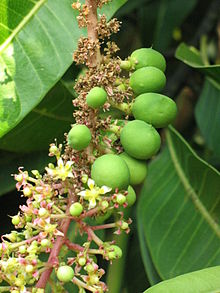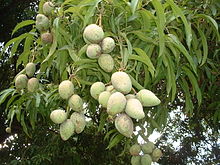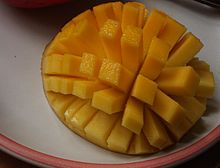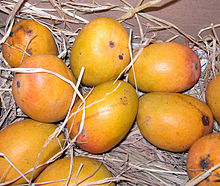
Mango
Background Information
SOS Children, which runs nearly 200 sos schools in the developing world, organised this selection. Click here to find out about child sponsorship.
| Mango (mangifera) | |
|---|---|
 |
|
| Scientific classification | |
| Kingdom: | Plantae |
| Division: | Angiospermae |
| (unranked): | Rosids |
| Order: | Sapindales |
| Family: | Anacardiaceae |
| Genus: | Mangifera |
| Species: | M. indica |
| Binomial name | |
| Mangifera indica L. |
|

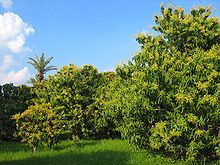

The mango is a fleshy stone fruit belonging to the genus Mangifera, consisting of numerous tropical fruiting trees in the flowering plant family Anacardiaceae. The mango is native to South Asia, from where it has been distributed worldwide to become one of the most cultivated fruits in the tropics. While other Mangifera species (e.g. horse mango, M. foetida) are also grown on a more localized basis, Mangifera indica – the 'common mango' or 'Indian mango' – is the only mango tree commonly cultivated in many tropical and subtropical regions. It is the national fruit of India, Philippines and Pakistan.
In several cultures, its fruit and leaves are ritually used as floral decorations at weddings, public celebrations and religious ceremonies.
Etymology
The English word "mango" (plural "mangoes" or "mangos") originated from the Tamil word māṅgai or mankay or Malayalam māṅṅa from the Dravidian root word for the same via Portuguese (also manga). The word's first recorded attestation in a European language was a text by Ludovico di Varthema in Italian in 1510, as manga; the first recorded occurrences in languages such as French and post-classical Latin appear to be translations from this Italian text. The origin of the "-o" ending in English is unclear.
When mangoes were first imported to the American colonies in the 17th century, they had to be pickled due to lack of refrigeration. Other fruits were also pickled and came to be called "mangoes", especially bell peppers, and by the 18th century, the word "mango" became a verb meaning "to pickle".
Description
Mango trees (Mangifera indica L.) grow up to 35–40 m (115–130 ft) tall, with a crown radius of 10 m (33 ft). The trees are long-lived, as some specimens still fruit after 300 years. In deep soil, the taproot descends to a depth of 6 m (20 ft), with profuse, wide-spreading feeder roots; the tree also sends down many anchor roots, which penetrate several feet of soil. The leaves are evergreen, alternate, simple, 15–35 cm (5.9–14 in) long and 6–16 cm (2.4–6.3 in) broad; when the leaves are young they are orange-pink, rapidly changing to a dark, glossy red, then dark green as they mature. The flowers are produced in terminal panicles 10–40 cm (3.9–16 in) long; each flower is small and white with five petals 5–10 mm (0.20–0.39 in) long, with a mild, sweet odour suggestive of lily of the valley. The fruit takes three to six months to ripen.
The ripe fruit varies in size and colour. Cultivars are variously yellow, orange, red or green, and carry a single flat, oblong pit that can be fibrous or hairy on the surface, and which does not separate easily from the pulp. Ripe, unpeeled mangoes give off a distinctive resinous, sweet smell. Inside the pit 1–2 mm (0.039–0.079 in) thick is a thin lining covering a single seed, 4–7 mm (0.16–0.28 in) long. The seed contains the plant embryo.
Cultivation
Mangoes have been cultivated in South Asia for thousands of years and reached East Asia between the fifth and fourth centuries BC. By the 10th century AD, cultivation had begun in East Africa. The 14th century Moroccan traveler, Ibn Battuta, reported it at Mogadishu. Cultivation came later to Brazil, the West Indies and Mexico, where an appropriate climate allows its growth.
The mango is now cultivated in most frost-free tropical and warmer subtropical climates; more than a third of the world's mangoes are cultivated in India alone, with the second-largest source being China. Mangoes are also grown in Andalusia, Spain (mainly in Málaga province), as its coastal subtropical climate is one of the few places in mainland Europe that allows the growth of tropical plants and fruit trees. The Canary Islands are another notable Spanish producer of the fruit. Other cultivators include North America (in South Florida and California's Central Valley), South and Central America, the Caribbean, Hawai'i, south, west and central Africa, Australia, China, Pakistan, Bangladesh, and Southeast Asia. Though India is the largest producer of mangoes, it accounts for less than one percent of the international mango trade; India consumes most of its own production.
Many commercial cultivars are grafted on to the cold-hardy rootstock of Gomera-1 mango cultivar, originally from Cuba. Its root system is well adapted to coastal mediterranean climate. Many of the 1,000+ mango cultivars are easily cultivated using grafted saplings, ranging from the "turpentine mango" (named for its strong taste of turpentine) to the huevos de toro. Dwarf or semidwarf varieties serve as ornamental plants and can be grown in containers. A wide variety of diseases can afflict mangoes; see List of mango diseases.
Food
The mango is generally sweet, although the taste and texture of the flesh varies across cultivars, some having a soft, pulpy texture similar to an overripe plum, while the flesh of others is firmer, like a cantaloupe or avocado, or may have a fibrous texture. For consumption of unripe, pickled or cooked fruit, the mango skin may be consumed comfortably, but has potential to cause contact dermatitis of the lips, gingiva or tongue in susceptible people (see below). Under-ripe mangoes can be ripened by placing them in brown paper bags. They will then keep in a plastic bag in the refrigerator for about four or five days. In ripe fruits which are commonly eaten fresh, the skin may be thicker and bitter tasting, so is typically not eaten.
Cuisine
Mangoes are widely used in cuisine. Sour, unripe mangoes are used in chutneys, athanu, pickles, or side dishes, or may be eaten raw with salt, chili, or soy sauce. A cooling summer drink called panna or panha comes from mangoes. Mango pulp made into jelly or cooked with red gram dhal and green chillies may be served with cooked rice. Mango lassi, a popular drink made throughout South Asia, is created by mixing ripe mangoes or mango pulp with buttermilk and sugar. Ripe mangoes are also used to make curries. Aamras is a popular pulp/thick juice made of mangoes with sugar or milk, and is consumed with bread, rice or pooris. The pulp from ripe mangoes is also used to make jam called mangada.
Mangoes are used in preserves such as moramba, amchur (dried and powdered unripe mango) and pickles, including a spicy mustard-oil pickle and alcohol. Ripe mangoes are often cut into thin layers, desiccated, folded, and then cut. These bars are similar to dried guava fruit bars available in some countries. The fruit is also added to cereal products such as muesli and oat granola.
Unripe mango may be eaten with bagoong (especially in the Philippines), fish sauce or with dash of salt. Dried strips of sweet, ripe mango (sometimes combined with seedless tamarind to form mangorind) are also popular. Mangoes may be used to make juices, mango nectar, and as a flavoring and major ingredient in ice cream and sorbetes.
Mango is used to make juices, smoothies, ice cream, fruit bars, raspados, aguas frescas, pies and sweet chili sauce, or mixed with chamoy, a sweet and spicy chili paste. It is popular on a stick dipped in hot chili powder and salt or as a main ingredient in fresh fruit combinations. In Central America, mango is either eaten green mixed with salt, vinegar, black pepper and hot sauce, or ripe in various forms. Toasted and ground pumpkin seed (called pepita) with lime and salt are the norm when eating green mangoes. Some people also add soy sauce or chili sauce.
Pieces of mango can be mashed and used as a topping on ice cream or blended with milk and ice as milkshakes. Sweet glutinous rice is flavored with coconut, then served with sliced mango as a dessert. In other parts of Southeast Asia, mangoes are pickled with fish sauce and rice vinegar. Green mangoes can be used in mango salad with fish sauce and dried shrimp. Mango with condensed milk may be used as a topping for shaved ice.
Nutrients and phytochemicals
| Nutritional value per 100 g (3.5 oz) | |
|---|---|
| Energy | 250 kJ (60 kcal) |
| Carbohydrates | 15 g |
| - Sugars | 13.7 g |
| - Dietary fibre | 1.6 g |
| Fat | 0.38 g |
| Protein | 0.82 g |
| Vitamin A equiv. | 54 μg (7%) |
| - beta-carotene | 640 μg (6%) |
| Thiamine (vit. B1) | 0.03 mg (3%) |
| Riboflavin (vit. B2) | 0.04 mg (3%) |
| Niacin (vit. B3) | 0.67 mg (4%) |
| Pantothenic acid (B5) | 0.2 mg (4%) |
| Vitamin B6 | 0.12 mg (9%) |
| Folate (vit. B9) | 43 μg (11%) |
| Vitamin C | 36 mg (43%) |
| Calcium | 11 mg (1%) |
| Iron | 0.16 mg (1%) |
| Magnesium | 10 mg (3%) |
| Phosphorus | 14 mg (2%) |
| Potassium | 168 mg (4%) |
| Zinc | 0.09 mg (1%) |
| Percentages are relative to US recommendations for adults. Source: USDA Nutrient Database |
|
The energy value per 100 g (3.5 oz) is 250 kJ (60 kcal), and that of the apple mango is slightly higher (79 kcal per 100g). Mango contains a variety of phytochemicals and nutrients. The fruit pulp is high in prebiotic dietary fibre, vitamin C, diverse polyphenols and provitamin A carotenoids.
In mango fruit pulp, the antioxidant vitamins A and C, vitamin B6 (pyridoxine), folate, other B vitamins and essential nutrients, such as potassium, copper and amino acids, are present. Mango peel and pulp contain other compounds, such as pigment carotenoids and polyphenols, and omega-3 and -6 polyunsaturated fatty acids.
Although not confirmed by sufficient science to date, mango peel pigments may have biological effects, including carotenoids, such as the provitamin A compound, beta-carotene, lutein and alpha-carotene, polyphenols such as quercetin, kaempferol, gallic acid, caffeic acid, catechins, tannins, and the unique mango xanthonoid, mangiferin, any of which may counteract free radicals in various disease processes as revealed in preliminary research. Phytochemical and nutrient content appears to vary across mango species. Up to 25 different carotenoids have been isolated from mango pulp, the densest of which was beta-carotene, which accounts for the yellow-orange pigmentation of most mango species. Peel and leaves also have significant polyphenol content, including xanthonoids, mangiferin and gallic acid.
The mango triterpene, lupeol, is an effective inhibitor in laboratory models of prostate and skin cancers. An extract of mango branch bark called Vimang, isolated by Cuban scientists, contains numerous polyphenols with antioxidant properties in vitro and on blood parameters of elderly humans.
The pigment euxanthin, known as Indian yellow, is often thought to be produced from the urine of cattle fed mango leaves; the practice is described as having been outlawed in 1908 due to malnutrition of the cows and possible urushiol poisoning. This supposed origin of euxanthin appears to rely on a single, anecdotal source, and Indian legal records do not outlaw such a practice.
Potential for contact dermatitis
Contact with oils in mango leaves, stems, sap, and skin can cause dermatitis and/or anaphylaxis in susceptible individuals. Those with a history of poison ivy or poison oak contact dermatitis may be most at risk for mango contact dermatitis. Cross-reactions between mango allergens and urushiol, a chemical in poison ivy and poison sumac that can cause dermatitis, have been observed. Urushiol is also present in mango leaves and stems. During mango's primary ripening season, it is the most common source of plant dermatitis in Hawaii.
Cultural significance
The mango is the national fruit of India, Pakistan and the Philippines. It is also the national tree of Bangladesh.
In Hinduism, the perfectly ripe mango is often held by Lord Ganesha as a symbol of attainment, regarding the devotees potential perfection. Mango blossoms are also used in the worship of the goddess Saraswati. No Telugu/Kannada New Year's Day called Ugadi passes without eating ugadi pacchadi made with mango pieces as one of the ingredients. In Tamil Brahmin homes mango is an ingredient in making vadai paruppu on Sri Rama Navami day (Lord Ram's Birth Day) and also in preparation of pachchadi on Tamil New Year's Day.
The Jain goddess Ambika is traditionally represented as sitting under a mango tree.
Mango leaves are used to decorate archways and doors in Indian houses and during weddings and celebrations like Ganesh Chaturthi. Mango motifs and paisleys are widely used in different Indian embroidery styles, and are found in Kashmiri shawls, Kanchipuram silk sarees, etc. Paisleys are also common to Iranian art, because of its pre-Islamic Zoroastrian past.
In Tamil Nadu, the mango is considered, along with banana and jackfruit, as one of the three royal fruits (Mukkani-முக்கனி) occupying first place in terms of sweetness and flavor. Ma-pala-vazhai (மா-பலா-வாழை).
Famous Urdu poet Mirza Asadullah Khan Ghalib was very fond of mangoes. There are many anecdotes concerning his love for mangoes. Rabindranath Tagore was fond of mangoes and has written poems about its flowers- aamer monjori. Poet Sa'd Bin Ard has written some poems about mangoes.
In the West Indies, the expression "to go mango walk" means to steal another person's mango fruits. This is celebrated in the famous song, The Mango Walk.
In Australia, the first tray of mangoes of the season is traditionally sold at an auction for charity.
The Classical Sanskrit poet Kalidasa sang the praises of mangoes. Historical records mention Mughal emperor Akbar ordering the planting of 100,000 mango trees.
Production and consumption
The Food and Agriculture Organization of the United Nations estimates worldwide production at nearly 35,000,000 tonnes (39,000,000 short tons) in 2009 (table below). The aggregate production of the top 10 countries is responsible for roughly 80% of worldwide production. India is the biggest producer of mangoes.
| Country | Production in millions of tons | |||
|---|---|---|---|---|
|
|
||||
|
|
||||
|
|
||||
|
|
||||
|
|
||||
|
|
||||
|
|
||||
| World total |
|
|||
|
Key ~ 2010 data Source Food And Agricultural Organization of United Nations: Economic And Social Department: The Statistical Division |
||||
Alphonso, Benishaan or Benisha (Banginapalli in Telugu and other south Indian languages) and Kesar mango varieties are the most popular varieties in India's southern states, while Chausa, Dasheri, Rataul and Langra also known as dudhia malda varieties are most popular in the northern states. Names of other varieties of mango available in India are malgova, peethar, rumani, bangalura, rasalu, thothapari, neelam, sindhoora, and salem.
Generally, ripe mangoes have an orange-yellow or reddish peel and are juicy for eating, while exported fruit are often picked while underripe with green peels. Although producing ethylene while ripening, unripened exported mangoes do not have the same juiciness or flavor as fresh fruit.
Like other drupaceous fruits, mangoes come in both freestone and clingstone varieties.
Cultivars
Many hundreds of named mango cultivars exist. In mango orchards, several cultivars are often crossed to improve pollination. Many desired cultivars are monoembryonic and must be propagated by grafting or they do not breed true. A common mono-embryonic cultivar is Alphonso, an important export product.
Cultivars that excel in one climate may fail elsewhere. For example, Indian cultivars such as Julie, a prolific cultivar in Jamaica, require annual fungicide treatment to escape a lethal fungal disease known as anthracnose in Florida. Asian mangoes are resistant to anthracnose.
The current world market is dominated by the cultivar Tommy Atkins, a seedling of Haden that first fruited in 1940 in southern Florida, U.S. It was initially rejected commercially by Florida researchers. For example, 80% of mangoes in UK supermarkets are Tommy Atkins. Despite its fibrous flesh and only fair taste, growers worldwide have embraced the cultivar for its exceptional productivity and disease resistance, shelf-life, transportability and size and appealing colour.



